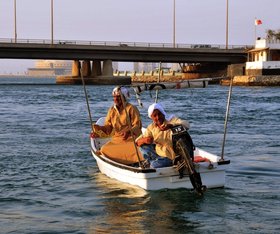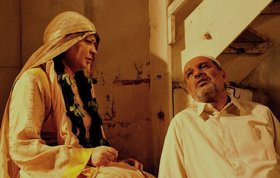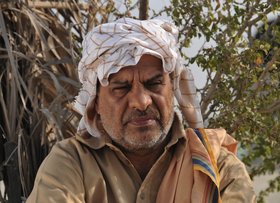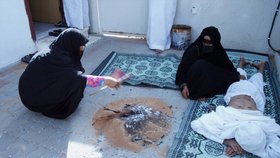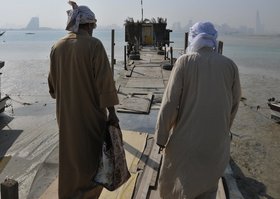Essays
Fast Forward to the Past
Cultural Institutions, Urban Development, and Regional Cinema in the Gulf Today
When drawing a visual image of the Gulf, it is perhaps difficult to dissociate it from the elaborate architectural renderings peddled by ambitious architecture and engineering firms, and the glittering vista of skyscrapers, highways, and man-made islands that have come to epitomize the area. Writer and critic Sheyma Buali takes a look at the new crop of films, be they shorts, documentary or narrative films, that look past the computer generated images (CGI) to the fast-disappearing reality beneath it – Bedouin life-styles, livelihoods based on fishing, homes made of stone rather than steel, and the attempts of local peoples to adapt to their new surroundings.
FAST FORWARD TO THE PAST: CULTURAL INSTITUTIONS, URBAN DEVELOPMENT, AND REGIONAL CINEMA IN THE GULF TODAY
Images of the newly shaping cities in the Gulf were, until the recent recession, saturating all media coming from the region. A certain disconnect between what was 'real', as in literally concrete, and what was being promoted as a place despite not really existing, was created. Computer generated images (CGI) of as of yet non-existent places, created using the latest in digital programming, were just as believable as the images of those that did exist. Public relations pundits were clever in creating a mishmash of real-versus-unreal to make what was yet only imagined a semi-reality. These illusory images of the future branded the region as forward-thinking, glitzy and up-to-par with the financial capitals of the world. In a sense, they worked to negate the fairly recent reality of so-called 'simpler' lifestyles. But locals had a different relationship to these developing landscapes.
The 'brand' that Gulf countries were trying to promote was composed of urban views and now tired sci-fi imagery, of mega-structure malls with water parks, ski parks, you name it, all were included in this diorama: futuristic buildings that were orientalist, ultra-modern and ultimately kitsch. Particular projects included the fantastical, and eventually thankfully scrapped, plans for Burj Al Arabi, a structure meant to look like an Arab man in a traditional Gulf man's dress, with the black band of his headdress intended to be a rotating restaurant. And the existing, yet ill-designed World Trade Center in Bahrain, the first to generate 30 per cent of its own electricity – if only it worked. The new cityscape, in its image and the reality expected to follow, was set to be the gateway to a new, ultra-modern era, making nationals living in these cities feel like they were experiencing an awkward, adolescent growth spurt but with the teething problems of a toddler.
As the plans to fast-forward urbanization of desert towns and 1980s oil wealth infrastructure became a reality, the question grew more pronounced: Where did the simpler life and familiar setting of the previous generation's sea-side desert towns go? In a bid to answer that question, areas within the cultural sphere started to rigorously catch up with the booming commercial and real estate sectors; particularly the heritage preservation and cinema industries, both independently as well as in combination. The theme of heritage and the past became a fixture in the thematic of the cinematic medium.
Whilst there is no overt argument against urban development, people's emotional psyches grasp on to nostalgia as part of their personal, historical identity. On the side of the 'heritage sector', focus fell on local histories and preservation. Each country began a distinctive project, mainly initiated by their respective governments. Bahrain's newly autonomous Ministry of Culture began a string of architectural preservation projects and developed small museums that teach and perform certain types of folkloric activities and interests like traditional weaving and pre-1960s music. In the Emirates there began the Emirates Heritage Club, the Sheikh Mohammed bin Rashid Al Maktoum Center for Cultural Understanding, and numerous oral history projects. Much of the aim of these projects was to explore the changing facets of everyday life, learn from the past, and – probably a more defining aspect – document and institutionalize scenes, memories and lifestyles that were dying out.
So it is no surprise that these issues would be visited through the flexible audio-visual medium of film, or that the young crop of filmmakers, looking to make their mark as representatives of their countries, would use it as fodder for their work. Bringing full circle the relationship between heritage sectors and the film industry, the two areas found each other at a crossroads. While some started to focus on traditional genre production, such as at Doha Film Institute's Mythology Lab, others created showcases focusing on heritage and generational gaps, Abu Dhabi's Heritage Film Festival in particular. As would naturally occur within filmmaking, investigations surrounding these issues do not only delve into ideas about life in the new urbanized setting, but also the image of what was then or is to come; in some cases metaphorically fleshing out the emotionality behind the CGI projections of the region. For the most part, this is negotiated through narratives of cultural loss, personal memories and spatial alienation.
Almost as if working in parallel, filmmakers in the Gulf are independently reassessing the past in conjunction with the current cities boom, initializing a new era of this modern art form with a stamp of existential exploration within a frame of local culture and loss of heritage. As cultural documents, these films share interconnected themes and a relevance to the imagination of the region regarding contemporary, real-life changes. Thematic similarities include urban reformation, increase in population, changes in daily culture, and ways of life lost to new spatial surroundings and their concomitant life-styles. Among the short films addressing these themes, all discussed further below, are: Hamama (2010), End of December (2011) and Al Seefah (2011), all from the Emirates; Ar'Riyadh (2010), from Saudi Arabia, and The Good Omen (2009) from Bahrain, to name but a few of these films. All of these were screened at the Dubai International Film Festival as part of 'Gulf Voices', a session reserved for films made regionally. They all eventually went on to Dubai's Gulf Film Festival. Certain ones, including Hamama and Al Seefah, were also screened at the Heritage Film Festival, organized with the German Goethe Institute in Abu Dhabi, putting them among films from other countries that also looked at the theme of heritage, the passing of time and changing of societal frameworks. Each addresses these themes using completely different styles and perspectives.
The 'Old Life'; or the (Recent) Past
The 'old life' yearned for in the Gulf context was not a life from that long ago. Only 50 years ago, the region was empty of most of its current infrastructure. Danish ethnographer Henny Hansen's 1960 monograph, Investigations in a Shia'a Village in Bahrain, described Sar – a town approximately 5km from the capital Manama – as a place without any electricity, where the wind-tower houses contained extended polygamous families. There were no markets in the now strip-mall-lined Budaiya Road that links to the city centre. At that time, the population of Bahrain was less than 150,000 people, a fraction of what it is today at 1.2 million.
News reel films made by the British mandate to document industrial developments at the time also illustrated this trajectory. A film announcing the creation of Port Rashid in Dubai in 1967 shows it as a smaller port bringing in basic imports, surrounded by a sprawling town where the tallest structure is a mosque minaret. Today, Port Rashid is a mammoth industrial port that hosts the most gigantic of world-travelling cruise lines and is back-dropped by monolithic skyscrapers. Elsewhere, images of Abu Dhabi in 1971 show sparsely-laid towered forts and palm-leaf homes in neighbourhood settings with no roads or signage surrounding them – a far cry from the images we see today of wavy buildings and rippled steel structures in various shapes, many still in concept stage. While different cities developed at different rates, the growth of the region as a whole since 1960 was astonishingly fast and was witnessed closely by the generation. The images depicting the vast changes that took place in Dubai in the last 15 years alone are testimony to that – something that has not come without its own internal problems. One interviewee of an oral history project conducted in the UAE remembers, 'Our times were beautiful, despite the simplicity of life and lack of money. People did not envy each other. Nowadays, hatred is everywhere. I remember how simple life was, despite the harsh and difficult living conditions'. [1]
Memories of this pre-concrete-and-glass, not-too-distant past is visited in the Emirati short film, End of December, directed by Hamad Al Hammadi, where one man's nostalgic thoughts subtly merge with his senility. After his room burns down, he remembers the old life by the calm sea. By the end of the film, the audience sees that this man's seemingly senile ramblings are in fact his memories, and he is longing to revisit this place of comfort. Also from the Emirates, and about the sea, is Al Seefah, a four-minute silent student film, which juxtaposes music and images of the past with brightly-coloured, busy images of the present day to remind viewers of times when the coast was principally used for fishing, the latter a deeply rooted ancestral livelihood. Previously this was a much freer practice, now it is regulated by laws and fines.
The Good Omen, directed by Mohammad Buali, looks back with sickly nostalgia – quite literally, as its protagonist dies of heart-ache for the past. Whilst not really looking at an old lifestyle in the narrative of the film, Buali uses a folkloric rite as the pivot for a story that looks existentially at the difference between the old town and new city. Here, nostalgia is an active force, in which an old man continually laments the disappearing practice of hanging a woman's traditional dress on top of the house to signify the return of a loved one. He has a dress ready to hang for his deceased wife whom he is yearning for, but her eventual return is marked by the fact that she comes to take him with her to death.
In all of these films, we are confronted with an unattainable past, where nostalgia is presented as a sickness. These films respond to that sentiment through alienation and distance and we see their characters as victims of social change. The threat here is that heritage within the landscape, whether visual or practical, will be erased, and the sense of self, home and belonging will be displaced. In that respect, and borrowing from L.P. Hartley's The Go-Between, published in 1970, 'the past is a foreign country; they do things differently there' - indeed, it is not the past that is a foreign country here, but rather the present.
The abruptness of the change in landscape has much to do with a persistent feeling of displacement; people did not leave the place, the place left them. Hansen's desert village of 50 years ago now overlooks skyscrapers that are designated homes for neoliberal aspirations, encouraging a new cosmopolitanism, completely different from the self-sufficient simplicity of before.
The award-winning documentary Hamama, made by Nujoom Al Ghanem, indirectly exposes this fast-paced change. The documentary is about Hamama Obaid Al Tinaiji, a medicine woman in her 80s. Her medical practice is based on traditional teachings of massage, herbal remedies and cauterization. But in the story about Hamama, we are also seeing the world changing. Besides the foreign feel of the city – which we only see once when Hamama goes to pick up an award recognizing her medical practice – we also see the stark newness of the residential development in which she lives and the construction of a new road in front of her house. As it is her custom to sit outside to have her coffee in the afternoons, this new road not only obstructs her view and takes up her space but threatens a lifestyle that she imagines for future children. At one point, her nephew comments, 'Having the road is a good thing, but Aunt Hamama wants to build a house from palm fronds. She wants to live in the past. Her dreams are small and simple. That's why she refuses the road'. Though she grew up as a Bedouin in the desert, her values and practices remained the same even when she moved to the city. Director Nujoom Al Ghanem comments, 'She is not against urbanization as long as it doesn't affect her own life style'. Here we see an account of one elderly woman's reaction to this change as peripheral to the main story.
Journalist Nadia Rahman, after conducting a series of interviews with elderly citizens in the UAE about the pace of change there, commented on their pride at being the hard-working generation who witnessed the discovery of oil. 'They are ambivalent, however, about buildings, cars and other trimmings of wealth', she said. 'The places of their youth no longer exist. Simple buildings and houses have been demolished to build skyscrapers and cities. So, the tension is one of pride in development and wealth versus nostalgia for the past and the simple life'.[2] Yasser El Sheshtawy, a prolific writer on Arab cities and Professor of Architecture at UAE University, is critical of these narratives. 'The typical architecture/urban narrative of the Middle Eastern city is a narrative of loss', he argues, and that it is an argument that is 'amplified through the current universalization (or globalization) discourse'.[3]
Different in its narrative form from the other films mentioned here, Ar'Riyadh is an observational film named after the city it ponders, guided by the inner thoughts of a young man walking around the streets of Riyadh, noting the effects of globalization. Despite its lo-fi production values, this film presents a city that is seldom glimpsed through raw images, natural sound and critical thought streams. Here we see the negotiation of the everyday person with their new surroundings through the obtrusively neon-lit new look of this populated, busy, noisy city. Sheshtawy continues, 'In architecture and urban design [globalization] is typically associated with a loss of place, identity, and character'[4] – a point that is commonly played out in the cinematic language. Besides their physical portrayal, with a strong parallel to the images of yet-to-be-realized Gulfie cityscapes, the individuals within these spaces treat the contemporary landscape as a distant reality: a place that they haven't fully reached yet. The Good Omen lays the city line of mainland Bahrain amidst a foggy haze from across the bay; Hamama's repetitive aerial view of her newly developed, Lego-like neighbourhood contrasts with the Bedouin health practice she conducts from inside her house; even Ar'Riyadh, as we walk with the narrator around this busy city, allows us to appreciate his thoughts as distant from the bustle, still contemplating it as alien; while End of December skews the audience's reaction to an older man's memories of the past, by allowing it to mistake them for senile thoughts. Al Seefah simply illustrates the new regulations of the seas versus yesterday's freedom within it, and functions as more of a frustration over new realities than a look into what is soon to come.
As governments have shown to prefer promoting their cities through character-generated architectural renderings, filmmakers have demonstrated a preference for sentimentally filling the gap left by what was once there with memories of it. What we are left with is a clash, similar to that felt by the elderly citizens in Rahman's interview project, between the CGI dreams presented as 'real', versus an emotional, memory-focused reality presented as cinematic nostalgia. So, in practice, why not merge these? The Gulf's fresh phase of cinema has, at this point, been galvanized by the Gulf film festival scene, mainly Dubai, Abu Dhabi and Doha's Tribeca. These grand events not only strongly serve their intention of filling the cultural lacunae, but also work at humanizing the otherwise harder, business-led branding of these cities by creating another parallel image. Revisiting local heritage through this art form and fanfare-laden events like film festivals examines the region's fast-moving development with emotional engagement and through personal histories, thereby serving to give depth to an otherwise shallow brand.
Beyond films looking at nostalgia from the viewpoint of the everyday civilian, more purpose-focused streams working in this vein developed. A film such as Black Gold (2011), though a critical flop, did something to highlight Qatar as a strong production option – aiming, in turn, to step onto a more global stage as a representative strong-hold for the whole Middle East – in its use of an internationally acclaimed cast. While not exactly nostalgic, it addresses a regional, historical past, ultimately making it a cultured and scenic business promotion, wrapped in the guise of a pertinent historical epic film.
These films are served as slices of warmth on multiple planes: in production, as cultural documents; in reception, with the local general public identifying with them as well as the foreign public learning from them; and finally, as the softer, more personable image of a region that has been catapulted, rather than segueing, into the twenty-first century. In using imaginative documentation, these films are a way of closing an old era by ultimately acting as dynamic thought processes in the grey area between a recent past and a clearly and literally visualized future. Examining a place where buildings are being designed, scrapped and erected while other areas are being neglected or demolished, these films, even in their dramatic reminiscences, offer points of discussion through the images, narratives and feelings they present and convey.
With the ongoing physical development of these cities, alongside the search for 'identity' through their (re)branding, the conflict between the old and the new is still being played out. The region's newly developing filmic art form's focus on identity, place and memory, offers a process of seeing what is, or will be, there. The question regarding urban shape and geographic form, whether actual, imagined or remembered, and society's proximity to it, will continue to change for as long as the landscape does. These films, in the meantime, stand in-between, evoking what once was there through a contemporary medium, offering a critical discussion through its reflected confusion, while at the same time remaining open to what is to come.

